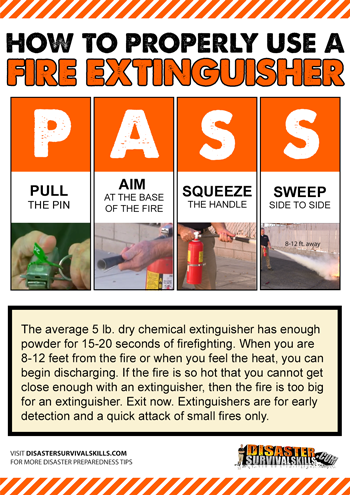Having the right fire extinguisher can mean the difference between a minor incident and a devastating loss. With over 25 years on the front lines of firefighting, I’ve seen firsthand how the right knowledge and tools can make all the difference in an emergency. Today, I want to share some friendly advice on picking the perfect fire extinguisher for your home. It's not just about having one; it's about ensuring you have the right one, knowing how to use it, and keeping your loved ones safe.
Rechargeable vs. Disposable: What's Best for You?
Think of fire extinguishers as an investment in your home’s safety. You’ll encounter two main types: rechargeable and disposable. While rechargeable models might seem pricier upfront, their ability to be refilled and reused makes them a lifelong safety asset. On the other hand, disposable extinguishers are for one-time use but cost less. My tip? Consider a rechargeable extinguisher for long-term savings and sustainability.
Watch this Fire Extinguisher Workshop
Here's something reassuring: fire extinguishers don't really "expire." They do, however, need some TLC. Keep an eye on the pressure gauge monthly; if it dips into the red, it's time for a check-up. Regular attention can extend your extinguisher's lifespan and ensure it’s ready when you need it.
Type of Fire Extinguisher

Fire extinguishers are labeled with A, B, or C (or combination). This tells you the types of fires the extinguisher can extinguish.
A – ordinary combustibles. Paper, wood, cloth, basically all non-metals. That is anything that burns and leaves an ash (A for Ash).
B– flammable liquids. Gasoline, oil, grease. Of course they come in barrels (B for Barrel).
C– electrical fires. Anything that is plugged in. And electricity carries a electrical charge (C for Charge)
Look for these 3 Letters A B C when purchasing your home extinguisher.
For most homes, an A-B-C extinguisher covers all the bases. Also, notice numbers before these letters (e.g., 3-A:40-B:C) — they indicate how effective the extinguisher is against each fire type. The higher, the better.
Size Matters, But So Does Weight
Bigger might often be better, but remember, you need to be able to use it comfortably.
Here’s my recommendation, choose a 5-10 lb. extinguisher for your garage or home workshop, especially if you have flammables, electrical equipment, etc.
A 2.5 lb. for your kitchen or laundry room.
And if you also want to get a fire extinguisher for your car, get a 2.5 lb. or 5 lb. with mounting hardware to keep it from rolling around in the trunk.
Where to Keep Your Fire Extinguishers
Placement is crucial. Ensure you have easy access by storing extinguishers in the kitchen and garage. In two-story homes, keeping one on each floor is wise. And, let’s not forget the car – a compact model with mounting hardware can be a lifesaver on the road.
You can also print this letter size poster on how to use fire extinguisher and post it beside your extinguisher.

Using Your Fire Extinguisher: The Basics
First call 9-1-1 and get the fire engine on the way, then grab your extinguisher and check the gauge to make sure the needle is in the green. This tells us that the extinguisher is charged with nitrogen, an inert gas that will blow the powder out of the extinguisher and onto your fire. You’re now ready to GO!
Next, refer to that acronym P A S S
- Pull the pin
- Aim at the base of the fire
- Squeeze the handle and
- Sweep side to side, just enough to cover the items burning.
Of course, don’t start discharging the extinguisher until you are 8 to 10 feet away. This is about the time you should start to feel the heat. And never start discharging any closer than 5 feet to the burning product or you will blow fire right back on top of yourself.
With a 5 lb. extinguisher, one you would typically see at your work, will discharge powder for about 20 seconds. Which may not seem like a long time, but in firefighting time, that is very long time. Most small fires should extinguish in 2-5 seconds.
A Note on Kitchen Fires
Since most fires at home start in the kitchen, here are some simple tips for kitchen stove fires. First turn off the flame to the stove, second grab the lid to the pan, hold it directly in front of you (using it as a shield) and simply place it on top of the pan, this will immediately extinguish the fire.
Fire Caution:
- Never use water on grease fires (steam explosion)
- Never use flour (dust explosion)
- Never use a dish towel (it will only add fuel to the fire if you don’t cover the pan completely)
Beyond the Extinguisher: Family Preparedness
Once you have the right fire extinguisher for your home and you know how to use it, take the next step in preparedness for your family. Go to our Family Calculator and simply enter the number of people in your home. It will generate a report with the items you need (in priority order) and quantities. The list covers first aid, fire, utilities, water, food, shelter, sanitation, car, and pets.
I’ve designed this tool to be quick and simple so that you can take action immediately. Give it a try, it’s free and if you find it useful, please share it with your friends.
Let’s make this year a year to get prepared.
Stay safe in the event of a fire with the Car Window Breaker and Seat Belt Cutter. This essential tool ensures a swift and safe escape during emergencies.

